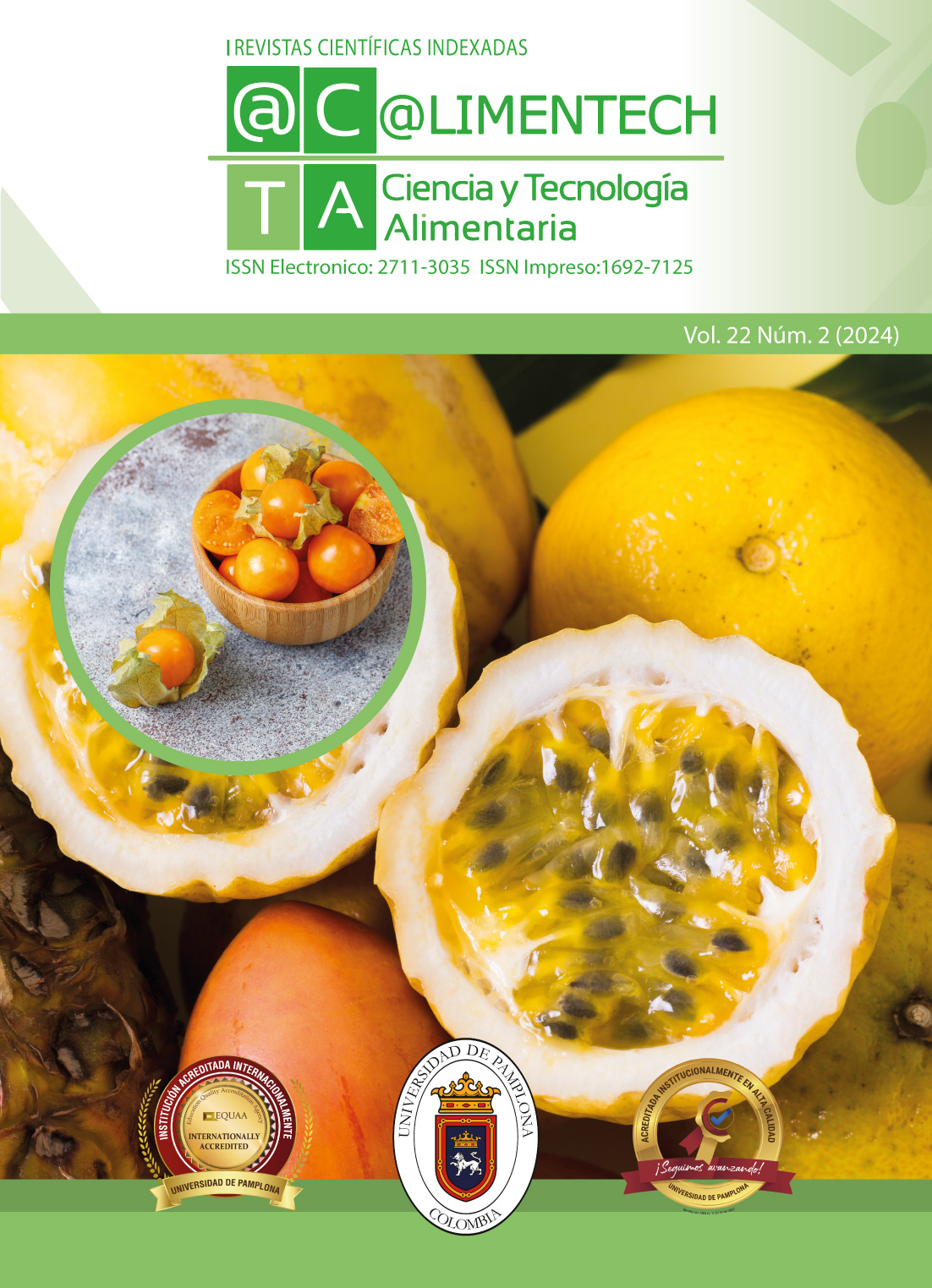Evaluation of the yield of fermented cocoa (Theobroma cacao L) beans by spray drying
DOI:
https://doi.org/10.24054/limentech.v22i2.3606Keywords:
Cocoa, Formulation, Spray Drying, , ProbioticAbstract
In the agricultural and food industry, different preservation techniques have been generated for raw materials and finished products, such as spray drying, which allow maintaining the organoleptic characteristics and phytochemical properties of the desired food; for its part, cocoa is one of the most important crops for export in Colombia, figures that in 2023 were close to 5600 tons of cocoa beans marketed, hence the need to ensure product quality and competitiveness of the cocoa regions of the country. The objective of the research was to evaluate the yield of the production of powder (microcapsules) of fermented cocoa beans and cocoa beans fermented and inoculated with probiotics under different conditions. The operating conditions of the spray drying process were proposed according to previous trials which resulted in: inlet air temperature 100 - 110 - 120°C, outlet air temperature 90-95°C, solids in the dispersion of (5.825 - 6.607%), with a constant feed of 15%, using 2% maltodextrin in a Buchi B-290 Mini spray dryer. The treatments evaluated were: natural fermented cocoa (T0), cocoa fermented and inoculated with probiotic at initial time (T1) and cocoa fermented and inoculated with probiotic at 48 hours (T2); which were defatted prior to use. The results showed that the fat-free cocoa bean powder for T0 and T1 presented a higher yield at a temperature of 100°C, respectively. The yield is mainly influenced by the air inlet temperatures, the cocoa fermented with probiotic insertion for 48 hours was not affected by the variation of temperatures, the treatments evaluated had no significant effect on the yield.
Downloads
References
Alcalá Raymundo, D. A., Benites Galindos, K. F., Lara Quispe, M. A., & Salinas Alvarado, C. F. (2022). Plan de negocio para una empresa comercializadora de cacao orgánico. Recuperado de: http://hdl.handle.net/10757/661009
Bueno-Pérez, Sandra Milena. (2023). Determinación de las propiedades ópticas y morfogeométricas de semillas de cacao tipo forastero de diversas cosechas. Revista @limentech, Ciencia y Tecnología Alimentaria. ISSN Impreso 1692-7125 ISSN Electrónico 2711-3035. Volumen 21 N° 3, Suplemento Especial. Pp: 5-20. https://doi.org/10.24054/limentech.v21i3.2935
Cortés, M.; Salazar, B.; Largo, E. (2018). Sugarcane Powder Biofortified with Kefir Grains: Effect of Spray Drying Process. Contemporary Engineering Sciences, Vol. 11, 2018, no. 62, 3063 – 3078. Doi: https://doi.org/10.12988/ces.2018.87303 DOI: https://doi.org/10.12988/ces.2018.87303
Criollo Lugmaña, V. F., & Paz Riofrío, H. P. (2022). Microencapsulación de una mezcla de aceite de palma, palmiste y estearina de palma (Elaeis guineensis) mediante el método de secado por atomización. Recuperado de: http://repositorio.espe.edu.ec/bitstream/21000/29338/1/T-ESPE-052307.pdf
Cruz Muentes, C. L. (2020). Desarrollo de pasta Fettuccine con sustitución parcial de la harina de trigo por harinas de achojcha (Cyclanthera pedata) y cascarilla de cacao (Theobroma cacao L.).
Departamento Nacional de Planeación DNP (2021). Azúcar, confitería y chocolatería. Estudio sobre cadenas productivas: Estructura, comercio internacional y protección. Bogotá D.C. Recuperado de: http://www.dnp.gov.co
Diaz Ramirez, L. M., Bravo Parra, A. M., Delgado Cuene, I. R., Rosas Sandoval, G., Gutierrez García, G. A., Vanegas Cubillos, M. C., ... & Hurtado Bermudez, J. J. (2023). Estrategia para la sostenibilidad de la cadena de cacao en Caquetá: Ruta hacia la acción climática y la construcción de paz. Recuperado de: https://hdl.handle.net/10568/137635
García-Rincón, P. A., Núñez-Ramírez, J. M., & Bahamón-Monje, A. F. (2021). Physicochemical and sensory characteristics of fermented almonds of national cacao (Theobroma Cacao L.) with addition of probiotics in the amazonic research center, Cimaz Macagual (Caquetá, Colombia). Ingeniería y competitividad, 23(2). Doi: https://doi.org/10.25100/iyc.v23i2.10885 DOI: https://doi.org/10.25100/iyc.v23i2.10885
Gharsallaoui, A., Roudaut, G., Chambin, O., Voilley, A., & Saurel, R. (2007). Applications of spray-drying in microencapsulation of food ingredients: An overview. Food research international, 40(9), 1107-1121. Doi: https://doi.org/10.1016/j.foodres.2007.07.004 DOI: https://doi.org/10.1016/j.foodres.2007.07.004
Pineda, L. A. P., Contreras, Y. M., Galarza, M. D. L. A., Morales, M. C., Marañón, A. H., Díaz, M. P. R., & Andrade, E. F. (2021). Clustering function and minimum change in spreading pressure as key factor to predict storage conditions for black pepper oleoresin encapsulated by spray drying. Food Bioscience, 42, 101215. Doi: https://doi.org/10.1016/j.fbio.2021.101215 DOI: https://doi.org/10.1016/j.fbio.2021.101215
Pinzon-Diaz, M., & Villalobos-Muñoz, A. K. (2020). Análisis de mercado del sector cacaotero de la región Alianza Pacífico y las oportunidades para-Colombia. Recuperado de: http://repositorio.uniagustiniana.edu.co//handle/123456789/1409
Rios-Aguirre, S., & Gil-Garzón, M. A. (2021). Microencapsulación por secado por aspersión de compuestos bioactivos en diversas matrices: una revisión. TecnoLógicas, 24(51), 206-229. DOI: https://doi.org/10.22430/22565337.1836
Sánchez Arizo, V. H., Zambrano Mendoza, J. L., & Iglesias Paladines, C. (2019). La cadena de valor del cacao en América Latina y el Caribe. Disponible en: https://repositorio.iniap.gob.ec/handle/41000/5382
Shaikh, J., Bhosale, R., & Singhal, R. (2006). Microencapsulation of black pepper oleoresin. Food chemistry, 94(1), 105-110. Doi: https://doi.org/10.1016/j.foodchem.2004.10.056 DOI: https://doi.org/10.1016/j.foodchem.2004.10.056
Unidad de Gestión de Riesgos Agropecuarios -UGRA (2020). Ficha de inteligencia: Cacao. Finagro. Ministerio de agricultura. Vicepresidencia de Garantías y Riesgos Agropecuarios. Recuperado de: https://www.finagro.com.co/sites/default/files/ficha_de_inteligencia_-_cacao.pdf
Vera R. José M.; Arrieta S. Alexandre; Quintana Lucas F.; García J. Alberto. (2017). Evaluación de las propiedades fisicoquímicas como parámetros de calidad en la fermentación de clones de Cacao CCN51, TSC01. Revista @limentech, Ciencia y Tecnología Alimentaria. ISSN 1692-7125. Volumen 15 N° 2. Pp: 76 -86. https://doi.org/10.24054/limentech.v15i2.2184. DOI: https://doi.org/10.24054/16927125.v2.n2.2017.2970
Downloads
Published
How to Cite
Issue
Section
License
Copyright (c) 2024 @limentech, Food Science and Technology

This work is licensed under a Creative Commons Attribution-NonCommercial 4.0 International License.








